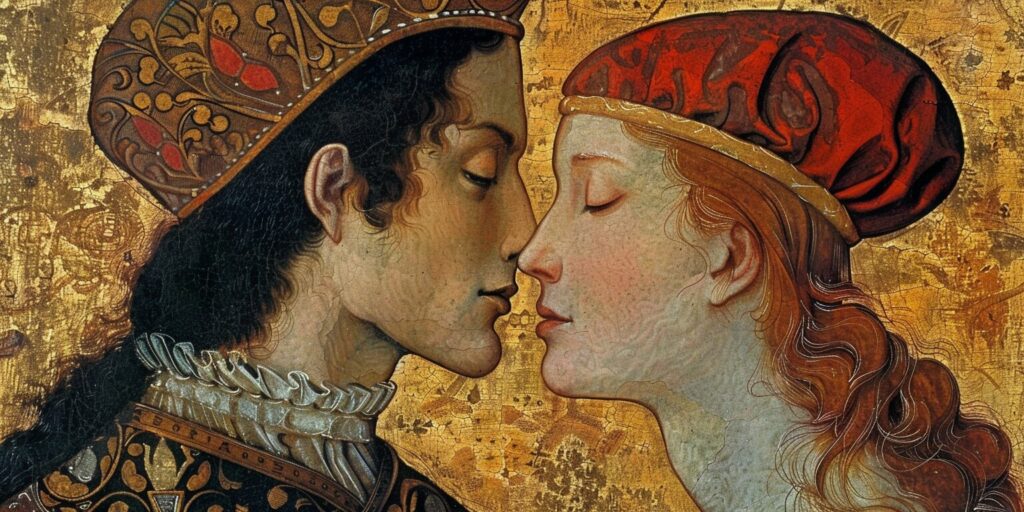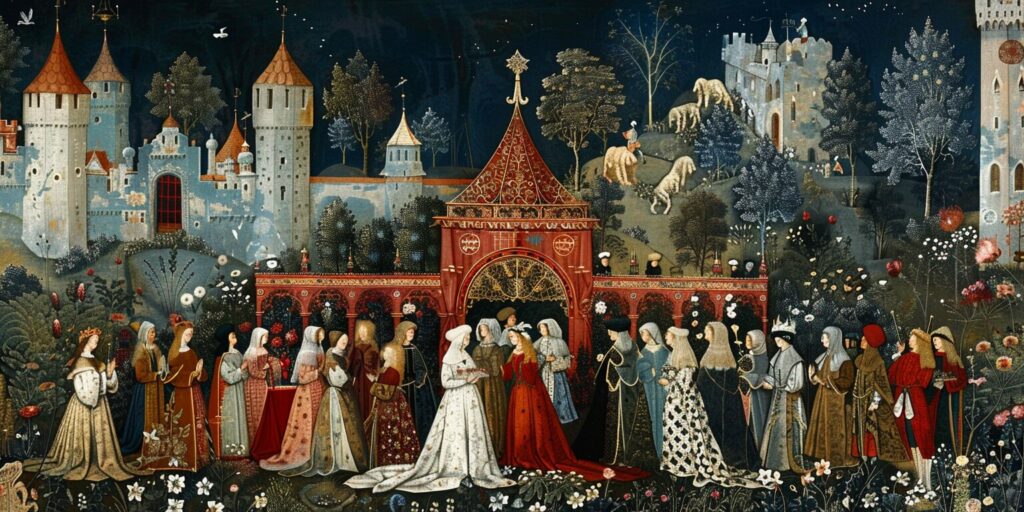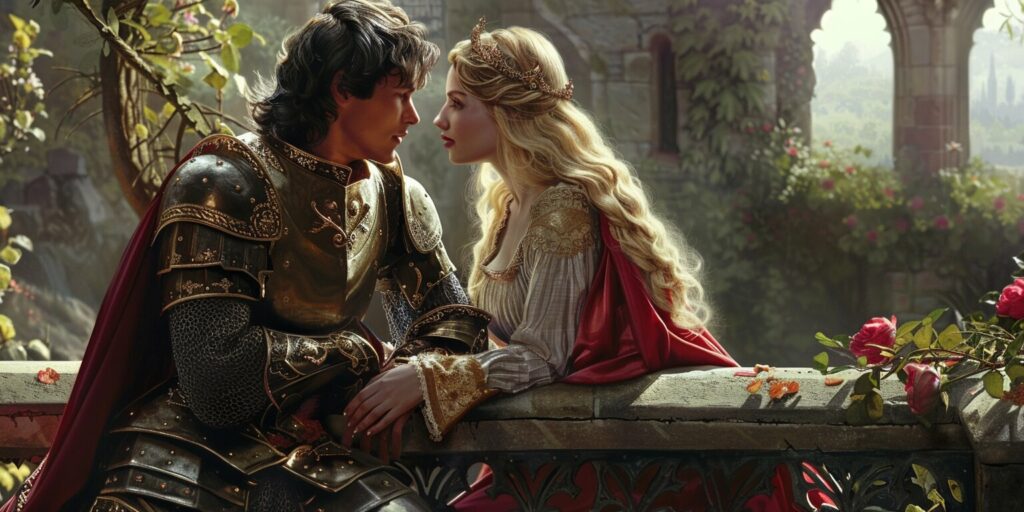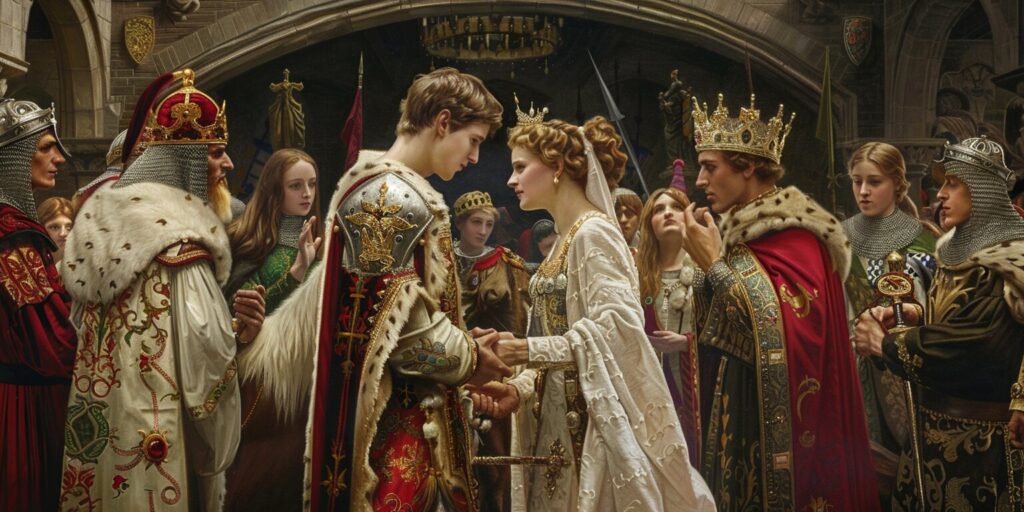Welcome to a captivating journey into the world of courtly love during the Middle Ages. In this section, we will explore the rules and rituals that governed medieval courtship, revealing the customs and ideals that shaped romantic relationships in this era, focusing on the practice of courtly love as a central element. From its origins and evolution to its portrayal in medieval literature, courtly love embodies a chivalrous tradition that fascinated and influenced society for centuries. Join us as we uncover the intricacies of courtly love and gain a deeper understanding of this romantic phenomenon, answering a popular question – what is courtly love?
Exploring the Concept of Courtly Love
In this section, we will explore the concept of courtly love in greater depth, tracing its roots to the troubadour tradition in Southern France.
The Origins and Evolution of Medieval Courtly Love
The concept of courtly love originated in the Middle Ages, particularly in the regions of Southern France and Northern Italy. It emerged as a response to the societal norms of the time, which dictated arranged marriages and limited personal choice in romantic relationships; hence, courtly love emerged as a revolutionary force. Troubadours, traveling poets, and musicians played a crucial role in popularizing courtly love through their songs and poetry.
Over time, courtly love evolved and incorporated elements from various cultural influences, such as the Arab-Islamic traditions of love poetry. It became a refined and complex system of devotion, highlighting the virtues of chivalry, nobility, and unrequited desire. The ideals of courtly love spread throughout Europe, shaping the romantic ideals of the medieval period.
The Four Rules of Courtly Love
Courtly love was guided by a set of rules and principles that governed the behavior of the lover and the beloved, forming the basis of what is known in medieval romance as the rules of love. These rules emphasized the unattainable nature of the beloved and the pursuit of love as an idealized, spiritual experience rather than a physical one. The four key rules of courtly love were:
- The lover should serve and worship the beloved, exalting them above all others.
- The lover should maintain a sense of secrecy and discretion, as courtly love often involved forbidden or illicit relationships.
- The lover should demonstrate humility and unwavering loyalty towards the beloved, even in the face of rejection or unrequited love.
- The lover should engage in self-improvement and strive to embody the virtues of chivalry, a concept central to the practice of courtly love and its representation in courtly love poetry.
These rules established a framework for courtly love relationships, emphasizing the virtues of devotion, sacrifice, and reverence.
The Ideal of Courtly Love in Medieval Literature
Courtly love became a prominent theme in medieval literature, particularly in the poetry and prose of the time, contributing significantly to the development of medieval romance and courtly love poetry. Poets and authors crafted elaborate tales of unrequited love, longing, and the pursuit of the idealized beloved. Courtly love was often portrayed as a spiritual and transformative experience, offering a path to personal growth and enlightenment.

One of the most famous examples of courtly love in literature is the tale of Lancelot and Guinevere, immortalized in Arthurian legends. Their forbidden love and the chivalrous code that governed their relationship captivated audiences and reflected the ideals of courtly love.
In addition to Arthurian legends, courtly love featured prominently in the works of troubadours, such as Bernard de Ventadorn and Geoffrey Chaucer. These poets celebrated the virtues of courtly love, crafting intricate verses and heartfelt ballads that resonated with audiences of the time.
Marriage and Love in Medieval Society
In medieval society, marriage was a significant institution governed by various practices and ideals. It played a crucial role in preserving social order and ensuring the continuity of noble families, largely through the practice of courtly love and its emphasis on chivalric and refined love.
Medieval Marriage Practices and Ideals
Medieval marriage practices revolved around arranged marriages, where considerations of social status, wealth, and alliances took precedence over individual choice. Marriages were often arranged by families and served as a means for consolidating power and expanding influence. The expectations of marriage were primarily rooted in the fulfillment of duties and responsibilities rather than romantic love.
Medieval society valued the institution of marriage for its role in procreation, establishing alliances, and maintaining social hierarchies. Women were expected to be obedient wives and mothers, taking care of domestic affairs, while men upheld their duties as providers and protectors.
Love and Marriage: Courtly Love’s Impact
The advent of courtly love introduced a new dimension to medieval marriages. Courtly love, with its emphasis on romance and idealized love, brought about a significant shift in the perception of marital relationships. It introduced the concept of passionate love outside the bounds of marriage and challenged the conventional ideals of matrimony.
Courtly love, which established a deep emotional connection and expressed intense desire, became central to the idea of love within marriage. The ideals of courtly love, such as devotion, admiration, and unattainability, influenced the expectations placed on both spouses. Courtly love introduced a nuanced understanding of love that complemented the traditional roles and responsibilities within marriage.
Love Outside of Marriage in the Middle Ages
Despite the emphasis on marriage as a social institution, love outside of marriage was not uncommon in the Middle Ages. Illicit love affairs were sometimes pursued, often fueled by the ideals of courtly love and the desire for personal fulfillment and emotional satisfaction.
The existence of extramarital affairs was a reflection of the complex realities of medieval society, where love and desire could transcend the confines of marriage. However, these affairs were not openly accepted or condoned, and they could carry severe consequences for those involved.
Ultimately, marriage in medieval society was shaped by various practices and ideals, including arranged marriages. The emergence of courtly love introduced new ideas and expectations within marriage, emphasizing romance and intense emotional connections, marking a departure from traditional matrimonial arrangements to a refined love that sought emotional fulfillment. Simultaneously, love outside of marriage existed in the form of illicit affairs, driven by personal desires and the allure of courtly love. Together, these factors contribute to our understanding of medieval society’s complexities of love and marriage.
The Impact of Courtly Love on Medieval Culture
In medieval culture, courtly love played a significant role in shaping societal norms and values. Its influence can be seen in various aspects of medieval life, including literature, chivalry, and the establishment of the Court of Love.
Courtly Love in Literature: Poems and Stories
Courtly love found expression in the literature of the Middle Ages, particularly in the form of poems and stories. Troubadours and famous poets of the era, such as Geoffrey Chaucer, Chrétien de Troyes, and Marie de France, composed works that celebrated and explored the ideals of courtly love. These literary pieces depicted knights and ladies engaging in chaste and often unrequited love, giving rise to a romanticized vision of courtly love that captivated readers and shaped their perception of romantic relationships.

The Role of Courtly Love in Chivalry and Knighthood
Courtly love played a pivotal role in the code of chivalry and the ideals of knighthood. Knights were expected to embody the virtues associated with courtly love, including devotion, loyalty, and honor. The pursuit of a beloved lady became a driving force for knights, inspiring them to perform acts of valor and uphold the principles of chivalry. Through courtly love, knights sought to elevate themselves both spiritually and socially, striving to become worthy of their beloved’s affection and admiration.
The Court of Love: Setting Rules for Romantic Pursuits
In the Middle Ages, the Court of Love emerged as an institution that defined and regulated the courtly love rules, crystallizing the practice of courtly love as a codified system. This court, often presided over by noble ladies, served as a forum for lovers to seek advice, resolve disputes, and adhere to a set of guidelines governing their romantic pursuits. The Court of Love provided a platform for the adjudication of matters of the heart, ensuring that courtly love adhered to its idealized principles. These rules, such as the requirement for secrecy and the prohibition of any physical intimacy, reinforced the notion of courtly love as a chaste and spiritual form of devotion.
The impact of courtly love on medieval culture cannot be overstated. It was a practice that deeply influenced the notions of romantic engagement during medieval times. Its presence in literature, influence on chivalry and knighthood, and establishment of the Court of Love all contributed to shaping societal norms and ideals. Courtly love permeated every aspect of medieval life, leaving an indelible mark on the culture of the time.
Notable Figures in the World of Courtly Love
Several notable figures emerged in the world of courtly love, leaving a lasting impact on the ideals and traditions of this chivalrous pursuit. Let’s explore some of these influential figures who shaped the landscape of courtly love during the Middle Ages, imprinting the medieval romance genre with their contributions.
Eleanor of Aquitaine: A Prominent Patron of Courtly Love
One of the most influential figures in courtly love was Eleanor of Aquitaine, the Queen of France and later the Queen of England. Eleanor was known for her patronage of troubadours and poets, who celebrated courtly love through their writings. She held courtly love in high regard and actively promoted its ideals, making her a prominent advocate of this romantic tradition.
Lancelot and Guinevere: Legendary Figures of Courtly Love
No discussion of courtly love would be complete without mentioning the legendary figures of Lancelot and Guinevere. Their ill-fated love affair, immortalized in Arthurian legends and medieval literature, exemplified the ideals of courtly love. Despite the societal constraints and the code of chivalry, Lancelot’s unwavering devotion to Guinevere became a symbol of the intense passion and sacrifice associated with courtly love.

Andreas Capellanus and the Art of Courtly Love
Andreas Capellanus, a 12th-century author and cleric, played a significant role in defining the principles and guidelines of courtly love through his treatise, “De Amore” or “The Art of Courtly Love.” In this influential work, Capellanus outlined the intricacies of courtly love, providing a guidebook for lovers seeking to navigate the complexities of romantic relationships during the Middle Ages, emphasizing the kind of love that was celebrated in courtly love poetry.
Exploring the Complexities of Courtly Love
In the world of courtly love, the interplay between romance and chivalry adds layers of complexity to relationships. The complexities of courtly love lie in the delicate balance between the fervent passion of romance and the strict code of chivalry that governs the behavior of knights and nobles.
In courtly love, the interplay of romance and chivalry is evident in the ideals and expectations imposed on lovers. Romantic relationships are characterized by adoration, longing, and unrequited love, while chivalry emphasizes honor, loyalty, and the pursuit of virtuous actions.
Love affairs and illicit relationships further complicate the landscape of courtly love in the Middle Ages. Despite the ideal of chaste love, the realities of human desires and emotions often led to clandestine affairs and secret liaisons. These love affairs existed both within and outside the confines of marriage, challenging social norms and adding intrigue to courtly love narratives.
Troubadour poetry played a significant role in celebrating courtly love and capturing its essence. Troubadours, the poet-musicians of the era, composed lyrical verses that expressed the complexities of courtly love. Their poetic works explored themes of longing, devotion, and the agonizing pleasures of love, often framed within the conventions of courtly love poetry and medieval romance. Troubadour poetry acted as a conduit for the expression of intimate emotions, giving voice to the nuances and complexities of courtly love.
In the high Middle Ages, courtly love evolved and reached new heights of refinement. The refined notions of love during this period focused on the art of wooing and displaying courtly manners. Knights and noblewomen engaged in intricate rituals and gestures to demonstrate their adoration and devotion. Love became an elevated concept intertwined with ideals of honor and nobility.
Conclusion
In summary, courtly love in the Middle Ages was a captivating and influential aspect of medieval society and culture, embodying love rules governing noble actions and sentiments. Through our exploration, we have uncovered this chivalrous tradition’s rules, rituals, and impact, highlighting the refined love characteristic of the 12th century. The concept of courtly love originated in Southern France, evolving over time and becoming an idealized form of romantic pursuit.
Throughout the Middle Ages, courtly love found its expression in literature, particularly in the poems and stories of famous troubadours and poets. These works showcased the virtues of courtly love and its influence on the code of chivalry and the ideals of knighthood. The Court of Love, an intriguing institution, further defined the rules for romantic pursuits, shaping the ideals of courtly love.
Furthermore, courtly love intersected with the institution of marriage, impacting the practices and expectations surrounding matrimony. While arranged marriages were prevalent during this era, courtly love introduced a new dynamic, emphasizing the ideals of passion and unattainability and establishing a refined love that sought to transcend societal constraints. Love affairs and illicit relationships also existed outside of marriage, adding complexity to the medieval understanding of love.
In summary, courtly love in the Middle Ages was a complex and influential phenomenon that shaped the customs and ideals of romantic relationships. Its influence extended from literature to society, influencing the code of chivalry and the institution of marriage. By understanding the intricacies of courtly love, we can gain insights into the rich tapestry of medieval culture and explore the enduring legacy of this chivalrous tradition.

